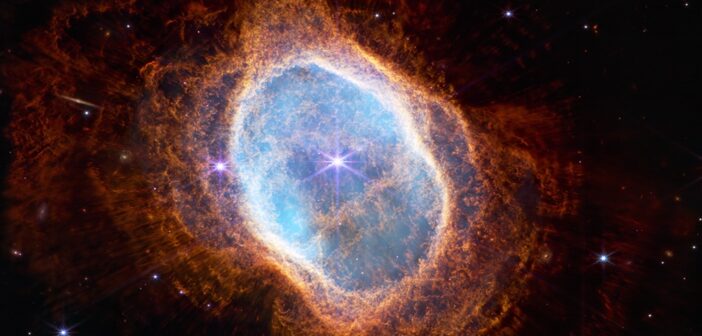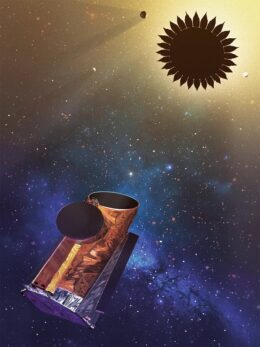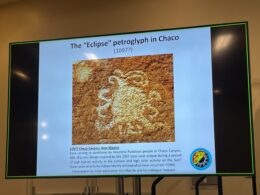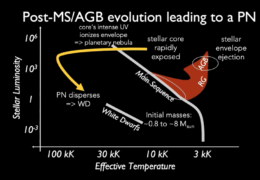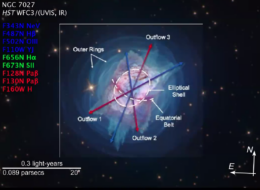Editor’s Note: This week we’re at the 242nd AAS meeting in Albuquerque, NM, and online. Along with a team of authors from Astrobites, we will be writing updates on selected events at the meeting and posting each day. Follow along here or at astrobites.com for daily summaries, or follow @astrobites on Twitter for live coverage. The usual posting schedule for AAS Nova will resume on June 12th.
Table of Contents:
- Plenary Lecture: John O’Meara (W.M. Keck Observatory)
- Press Conference: Get Ready for the North American Solar Eclipses
- Plenary Lecture: Joel H. Kastner (Rochester Institute of Technology)
- Plenary Lecture: Kathryne “Kate” Daniel (University of Arizona)
- Plenary Lecture: Klaus Pontoppidan (Space Telescope Science Institute)
Plenary Lecture: John O’Meara (W.M. Keck Observatory) (by Junellie Gonzalez Quiles)
The first plenary lecture of the day, titled “Now What? Making Astro2020 a Reality,” was given by John O‘Meara from W.M. Keck Observatory. He started by acknowledging the land that Albuquerque is on and acknowledging the Indigenous people of this land. He then talked about the Decadal Survey and how it has “controlled our destinies” since 1964. He showed the front pages of the decadal surveys throughout the years and mentioned the different missions that the various surveys prioritized. The Astro2020 Decadal Survey hopes to prioritize topics including Worlds and Suns in Context, New Messengers, and New Physics and Cosmic Ecosystems. John tried to put all of the priorities from the Decadal Survey in one question: How did the universe enable biology? With the recommendation of the Habitable Worlds Observatory (see Figure 1), he encouraged the attendees to think about it in two ways: Habitable Worlds (for looking for new worlds in the universe) and Observatory (for studying the mysteries of the universe).
John had a wish before the Astro2020 Decadal Survey was released: “I wish for a bold, visionary, pragmatic, and actionable report that not only sets the stage for scientific discovery that can change humanity, but also for a path for humanity to change how it does astronomy.” He shares that his wish was granted when the report came out! But, then he explained he felt like the fish in plastic bags floating in the ocean in Finding Nemo, asking himself, “Now what?” When thinking of this question, he realized that to enable great science, we need funding. He then evaluated the budget that we get to do astronomy research, which is around 0.025% of the US budget. John remarks that even though that seems like a tiny portion, it is still over one billion dollars! But, the current budget for the Astro2020 Decadal Survey is the Fiscal Year (FY) 2024 budget, which doesn’t have enough for the field to fulfill its goals. Therefore, we still need more funding for FY 2024, and John mentions that the budget is very similar to ping pong, where there is a lot of back and forth with the government to be able to get the necessary funding. He then says the budget is like a moving dumpster fire on a truck. But who is driving the truck? We are! John highlights the power we all have to make a difference in the budget and in general with policy matters. He emphatically says to “get out there and start talking!”
John nears the end of his talk by pointing out that we need a long term solution to how we operate facilities and that while the science leadership of the United States is at risk, there is still an immense opportunity to improve and strengthen it. “There is no such thing as a partisan photon,” he emphasizes, and impressed upon the audience that all political parties do care about science in their budgets, and we shouldn’t assume they don’t. John transitions to talking about JWST and how long it took to get the mission going and encourages us to think about how we can improve the process for the Habitable Worlds Observatory. He also highlights the different programs created for the Habitable Worlds Observatory and how we can all get more involved!To conclude his plenary, he then highlights the importance of improving the state of the field, how crucial it is to support and lift the voices of the LGBTQ+ community as well as the voices of minority groups if we want to create a better environment for people to thrive in their search to understand the universe.
Twitter thread of plenary lecture by Junellie Gonzalez Quiles.
Press Conference: Get Ready for the North American Solar Eclipses (by Sumeet Kulkarni)
The final press conference of AAS 242 focused on two exciting solar eclipses gracing North America within the next 12 months: the annular eclipse on October 14, 2023, and the Great North American total solar eclipse on April 8, 2024.
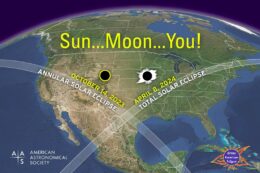
The paths of annularity and totality for the upcoming solar eclipses across North America. Click to enlarge. [AAS]
Rick Fienberg, who leads the AAS solar eclipse task force, followed Speck by providing tips and guidelines on how to experience these eclipses, particularly the 2024 total solar eclipse. “You may want to drive the shortest distance (to totality),” he said, “but an important consideration is to look up the expected cloud cover at that time of the year.” Here is one resource that can help us keep track of this. Only going into the path of totality can offer one the complete eclipse experience. The Sun is so bright that our pupils do not start dilating to compensate for the decrease in light even when it is 75% blocked. Even when it’s 95% blocked (e.g., in an annular eclipse or 5 minutes before totality), it is still as bright as a cloudy day. “There is no such thing as a 99% total eclipse. It’s all or nothing,” Fienberg said.
Fienberg went on to stress the importance of safety in eclipse viewing. It is safe to look at the Sun with the naked eye (and even binoculars and telescopes) ONLY when it is completely blocked during totality — but one should be very careful to know exactly when totality ends. At any other time during the eclipse, or during a partial eclipse or even during the maximum coverage of an annular eclipse, everyone absolutely needs to wear protection. Safe solar filters only transmit 1 part in 100,000 of the sunlight intensity. Fienberg advised buying eclipse glasses and filters that pass standards or from suppliers listed on this AAS page. Detailed information on how to safely observe the eclipse is also available on https://eclipse.aas.org/.
Jayne Aubele from the New Mexico Museum of Natural History and Science next gave a local flavor of observing the October 2023 annular eclipse from Albuquerque, which she labeled as ground zero for this eclipse. It is expected to begin around 9:15 am and last almost three hours. The full annularity will start from 10:34 am and last 4 minutes and 45 seconds. To add further excitement, October 14th is also the last Saturday of the renowned International hot air balloon fiesta in Albuquerque! However, for anyone hoping to enjoy a dual balloon-eclipse ride, Aubele noted that the last balloon comes down well before the time full annularity will hit.
The following two presentations were given by Craig DeForest and Cherilynn Morrow, representing the Southwest Research Institute and NASA’s Polarimeter to UNify the Corona and Heliosphere (PUNCH) mission. DeForest spoke about Citizen CATE (Continental-America Telescopic Eclipse), a novel experiment that aims to capture images of the inner solar corona using a network of more than 60 telescopes operated by citizen scientists, high school groups, and universities. While the total solar eclipse will only last about four minutes from any given location, anyone interested in studying the Sun’s corona would not see it change much during this time. However, with the help of volunteer citizen scientists across the entire path of totality, the Citizen CATE project plans to make a 60+ minute movie of the Sun as it is blanketed by the Moon and showcasing its brilliant corona. These results will help augment PUNCH, NASA’s own mission that studies the solar corona.
Morrow followed up by stressing the importance of connecting our own eclipse viewing experience with that of other cultures and people belonging to generations preceding us. To this effect, NASA PUNCH aims not to have target audiences, but collaborators, including Native American/Hispanic youth and families, as well as blind and low-vision learners. “There are some cultures that don’t want to look at the eclipse” that we need to be cognizant of, Morrow said. Some people will be fasting and praying — it’s important to know this as we prepare our community outreach efforts. She concluded by reminding us about how ancient people witnessed the same phenomenon here that we are about to, by showcasing the fascinating eclipse petroglyph from the year 1097 AD in Chaco Canyon close to Albuquerque. These stone carvings possibly represent a total eclipse during high solar activity (lots of coronal spikes) and a nearby Venus!Live tweets of this session by Sumeet Kulkarni.
Plenary Lecture: Joel H. Kastner (Rochester Institute of Technology) (by Wei Vivyan Yan)
This plenary talk was delivered by Dr. Joel H. Kastner from the Rochester Institute of Technology. Dr. Kastner shared the latest studies on planetary nebulae (PNe; singular PN), which impact fundamental topics such as products of asymptotic giant branch (AGB) nucleosynthesis, late stages of interacting binary systems, origins of white dwarfs, and jet launching.
Dr. Kastner first introduced where PNe are located in the stellar evolution diagram (Figure 1). When a solar- to intermediate-mass star (~0.8–8 solar masses) grows old and moves away from the main sequence, it enters the AGB region, where its stellar envelope ejects and its stellar core rapidly is rapidly exposed. Intense ultraviolet emission ionizes the envelope when the core hits a temperature of ~30000K, which creates a glowing nebula. Eventually, this PN disperses and evolves into a white dwarf. The star loses ~30%–80% of its initial mass during this process. Therefore, as white dwarf generators, PNe document the “end game” of stellar evolution and provide unique insight into the initial-to-final mass relation from the stellar mass loss.Dr. Kastner then showed the “classical” structure model of PN formation (left panel in Figure 2), demonstrating different layers and interacting winds inside a PN. When the AGB star ejects its envelope, the inner shock produces fast winds (velocity ~1,000 km/s) and forms the inner layer called the “hot bubble.” Dr. Kastner presented many X-ray observations as the key to unveiling wind interactions. For example, we can see very clear shells and layers in the images from ChanPlaNS (Chandra X-ray survey of PNe), which revealed the “hot bubble” and central stars emitting X-rays (right panel in Figure 2).
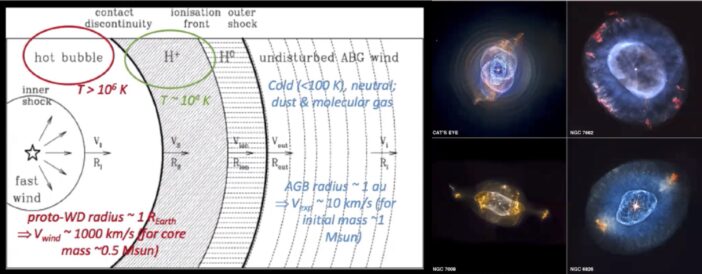
Left: The classical structure of a PN (Marigo et al. 2001). Right: X-ray images of PNe with different morphologies from ChanPlaNS. [Kastner et al. 2012, Freeman et al. 2014, Montez et al. 2015; Visualization credit: K. Arcand]

A bipolar PN with two lobes, a pinched waist, and a binary companion inside a torus structure. [Slide by Dr. Joel H. Kastner]
Dr. Kastner suggested two different (binary/multiple stars) origin stories for PNe with different morphologies based on how much molecular gas they have. Bipolar and ring-like nebulae contain rich molecular chemistry, observed by the Atacama Large Millimeter/submillimeter Array (ALMA) and the Submillimeter Array, and tend to dominate detections of molecular gas. On the other hand, round or elliptical PNe with X-ray-emitting bubbles generally lack detectable molecular gas.
Dr. Kastner concluded this talk with many open questions and future directions in PN research. In addition to the challenges in the binary hypothesis for PN shaping, Dr. Kastner wanted to use upcoming data and instruments (e.g., eROSITA, ALMA) to better understand how shocks persist, the spatial distribution of molecular masses, and the evolution of light-element abundances over cosmic time. “We are standing at the astrophysical crossroads,” says Dr. Kastner.
Twitter thread for this session by Wei Vivyan Yan.
Plenary Lecture: Kathryne “Kate” Daniel (University of Arizona) (by Emma Clarke)
“This one is gonna be special,” said Grant Tremblay as he began to introduce the next plenary speaker, Kathryne “Kate” Daniel. “No pressure on Kate,” he added. If there was pressure, Kate Daniel didn’t show it. She began with a thanks for the introduction, followed by opening remarks of her own — in an Indigenous language of her ancestors. Translating, she repeated “Hi, I’m very happy to be here,” shared her name, and explained that she is of Comanche, Chickasaw, and European heritage. She conveyed honor and respect to her ancestors and the people who came before her, as well as her colleagues, the AAS, NSF, NASA, and the Heising-Simons Foundation, and recognized the Sandia and Ancestral Puebloan peoples, whose homeland AAS 242 is being held on.
She then explained a game her grandfather used to play with her. He would invite her to look at a bird, for example, and think about what the bird was thinking. Next, he’d ask her to imagine sitting on the back of the bird, and to think about what it felt like, what it looked like, and what the surroundings looked like. Finally, he would ask her to think like the bird, to be like the bird, and know like the bird. She explained that this was an important lesson in perspective; that there is no central perspective, much less her own, and that she exists in and with and in relationship to the world. She encouraged the audience to play this game during her talk.

The central bulge of the Milky Way Galaxy has a boxy-peanut shape. [Slide from K. Daniel with figure from Ness et al. 2016.]
Dr. Daniel then explained the work that she and her students and other collaborators have done to study the internal evolution of galaxies and galaxy structure. In particular she discussed dynamical resonances, such as the “corotation resonance,” a way in which orbits can be rearranged in the disk of a galaxy without any other kinematic signatures. She explained that as orbits evolve, the morphology evolves and emerges. Another important takeaway is that there is rich structure in galaxies such as the Milky Way, which is not in an equilibrium state, but has the influence of spiral arms. She concluded by noting that the works she presented, which all aim to understand the structure and internal evolution of galaxies, try to understand the same problem from multiple perspectives and that this has led to deeper knowledge and understanding.
In the second part of her talk, Dr. Daniel spoke specifically in terms of two-eyed seeing, an approach which applies both Western and Indigenous perspectives. She started by showing an image of Mauna Kea from two perspectives: one showing the observatories on the top and the other a representation of the cultural importance of Mauna Kea. She argued that the two images are not mutually exclusive; that it is not astronomy or cultural significance, but rather “and.” She explained that the only way to find “and” is through relationships. Along this vein she highlighted community-based models of astronomy. In particular, she described Cosmic Explorer, a future experiment which she is a director of. This gravitational wave experiment is named 24 times in the ASTRO2020 decadal survey, which identifies the priorities of the astronomy community. (Dr. Daniel encouraged everyone to have a look at the appendices of ASTRO2020 to see the reports from individual panels, and not just the executive summary, which is a compilation of the reports!) Cosmic Explorer increases gravitational wave sensitivity (over LIGO) tenfold and promises unprecedented and transformation science, but not only that — it takes power sharing with the community to heart. This is notable in its management structure, which has directors for areas including DEI and Land Partnerships. She noted that we have not only the responsibility but also the opportunity to do things differently and think about power sharing models. For example, scientists work with the public even before naming a location for observatories.

Photograph of the top of Mauna Kea; Right: Representation of the cultural importance of Mauna Kea. [Slide from K. Daniel]
Dr. Daniel concluded by tying both parts of the talk together, explaining that two-eyed seeing is about gaining dimensions: in perspective, in problem solving, an understanding the universe, and in the manner in which we exist. She explained that the collection of dynamics — whether in galaxies or among people — leads to emergent dynamics. “We have the ability to guide ourselves into emergent structures to broaden participation and evolve into something we may not otherwise imagine.” With that, she thanked the audience — in English and the languages of the Comanche and Chickasaw.
Plenary Lecture: Klaus Pontoppidan (Space Telescope Science Institute) (by Junellie Gonzalez Quiles)
The last plenary talk of the day was given by Dr. Klaus Pontoppidan from the Space Telescope Science Institute. He talked to us about the “Origin of Rocky Planets and their Atmospheres: A Rhapsody in Infrared.” He started by talking about the Roskilde Cathedral in Denmark, an example of a church that would take a very long time to make and those who started working on it would maybe not see the end result. He draws the parallel with astronomy and future observatories; these missions take years to build and future generations will be the ones using these telescopes. Klaus has been involved with JWST and is part of the team that produced the first images of the mission!
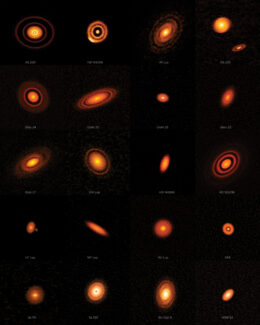
Twenty images of protoplanetary disks captured by ALMA’s large program called DSHARP. [ALMA (ESO/NAOJ/NRAO), S. Andrews et al.; NRAO/AUI/NSF, S. Dagnello]
The speaker then shows detailed images of protoplanetary disks where dark gaps can be seen at large radii, which leads to the question of whether planets could be forming at such large radii in these systems. For several years, the Spitzer spectra of planet-forming disks looked smooth, but another group published the first detections of water and organics. Klaus then thought to himself, could the Spitzer data reflect that? He went back to the Spitzer legacy surveys and removed some methods used to analyze the data and found water! Then to connect it with JWST, Klaus found JWST-MIRI does not trace water all the way out to the snowline. To finish the talk, the speaker talked about characterizing the chemical diversity of planet-forming regions and shared that there is an upcoming paper talking about many water lines detected through the survey!
Twitter thread of plenary lecture by Junellie Gonzalez Quiles.

